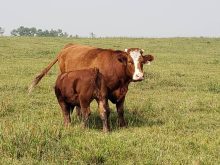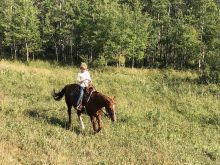Prior to April 2, U.S. and Canadian cattle producers were bracing for U.S. tariffs to be placed on beef and cattle.
However, goods imported under the existing continental trade deal, known as CUSMA, will not face tariffs, while those outside the deal will see a 10 per cent tariff. In the table here we have a list of countries that exported beef to the U.S. and volume for the 2024 calendar year.

The top exporters to the U.S., excluding Canada and Mexico, shipped 1.345 million tonnes of beef in 2024. This tariff policy was viewed as bullish for North American beef and cattle markets. Brazil is unique because it managed to fill its entire 2025 tariff-free access volume to the U.S market in just 17 days in January and was now subject to 26.4 per cent on all beef shipments for the remainder of 2025.
Read Also

Gentle treatments for pain in the neck
Heading toward year-end, people unknowingly tense up against the cold and busyness, causing neck pain that can often be treated with appropriate support and gentle mobility, athletic therapist Kathlyn Hossack says.
Australia had a tariff free quota for 448,000 tonnes negotiated under the 2005 U.S.-Australia Free Trade Agreement but now this will have a 10 per cent tariff. Apparently, Nicaragua will face an 18 per cent tariff. From a supply perspective, the tariffs are bullish for Canadian cattle and beef prices.
The imposed U.S. tariffs will result in lower beef demand. The U.S. tariffs are expected to cost the average household between $3,500 and $4,500 per year. There are about 100 million households in the U.S with average earnings around $100,000.
The cattle market usually lags equity markets by four to six months. It takes time for companies to realize lower earnings and start reining in spending and laying off employees. The U.S. tariffs will result in rising unemployment and higher prices on the retail shelf. Companies such as Wal-Mart, Target and other retailers have voiced concerns about the tariffs and lower consumer spending. These companies import a fair amount of products from clothing to electronics from China and Southeast Asia. In that way, tariffs are very protective; they protect the consumer from low prices.
Wholesale beef prices have been percolating higher. In early April, wholesale choice product was valued at US$340/cwt, up from the March average level of US$325/cwt and up from the April 2024 mean value of US$298/cwt. The wholesale beef market is functioning to ration demand. Retail beef prices are also setting fresh historical highs in the U.S. Beef is often used as a loss leader to attract customers, but grocers are now pricing beef according to cost basis with minimal margin.
The fed cattle market was quiet during the first week of April with limited trade. The final week of March saw U.S. packers buying fed cattle in southern Alberta in the range of $285-$292/cwt f.o.b. the feedlot. Alberta packers were buying fed on a dressed basis in the range of $450-$460/cwt delivered. Using a 60 per cent grading, this equates to a live price of $270-$276/cwt delivered. U.S. bids are a sharp premium to the Alberta market as Alberta packers were factoring in a risk discount in preparation for the tariffs.
Alberta and Saskatchewan cattle on feed 150 days or longer as of March 1 were only 45,609 head, down 84,586 head from last year. Nearby supplies are rather snug. Feedlot margins have been in the range of $150-$300 per head on March pen closeouts and this has supported the feeder market.
In east-central Saskatchewan, steers weighing 800 lbs. were trading in the range of $400/cwt to as high as $420/cwt. Quality steer calves have been trading in the range of $550/cwt to as high as $580/cwt. For August delivery, steers weighing 1,000 lbs. have been trading in the range of $350-$360. Producers can probably use this as the price discovery when buying grassers. Don’t expect much upside beyond this level, because the beef and cattle complex will likely come under pressure during the summer months, especially if there are significant layoffs.
I’ve encouraging cow-calf producers and backgrounding operators to use the price insurance for nearby and fall marketings. Market-ready supplies of fed cattle are relatively tight in the short-term.
However, during summer, market-ready cattle numbers will increase and demand is expected to be down from last year. U.S. corporate profits were record-high in 2024. There is a tendency for a natural correction or a slower pace of growth after an extreme. However, with the tariffs, companies are worried about just being profitable. U.S. gross domestic product (GDP) could drop to negative four per cent in the first and second quarters. Two quarters of contraction is technically considered a recession. The tariffs could cause a full-out depression like the 1930s. Producers need to be careful because there is significant downside price risk in the cattle market.
















